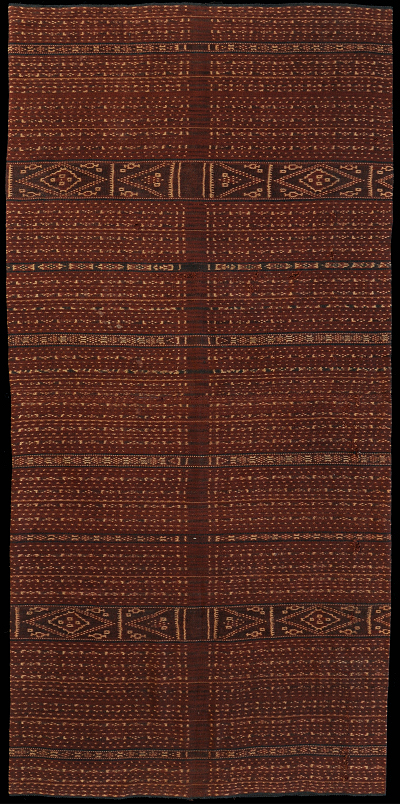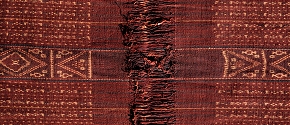| |
 
 | | | |
007 Flores Group, Peninsula
Kewatek (sarong)  
| | Locale: | Ili Mandiri (most likely), Bama, Lewolaga, or Lobe Tobi. Due to great stylistic similarity exact provenance may be impossible to pin down. | | Period: | Early 20th c. | | Yarn: | Cotton, hand-spun, medium | | Technique: | Warp ikat | | Panels: | 2 | | Size: | 150 x 172 cm (4' 11" x 5' 7") LW: 1.15 | | Weight: | 860 g (30.3 oz), 167 g/m2 (0.55 oz/ft2) | | Design: | Kewatek méan made of two panels. Two bands, called kenirek belen, with patola inspired motifs clearly belonging to the Lamaholot vernacular, in a field filled with numerous narrower bands and stripes with fine ikated motifs, executed in morinda red, in three shades, the darkest created by belapit: overdyeing with indigo. While the more common kewatek méan, a type known as odo pito, in its main ikated bands makes use of tied bundles seven threads wide, in this fine example bundles only four threads wide are used. | | Comment: | Important kewatek méan in virginal condition, with its warp threads uncut - vital for its potential to be used as bridewealth. Executed in three shades of morinda, as required for use as bridewealth. The intricate detailing and uncommonly rich colour saturation points to a very long dyeing process with either prolonged or repeated steeping in the dye. Production of this cloth may be well have taken five years or more. One 7.5 cm (3 in) cm tear' and about a dozen tiny holes on the 'backside, front side immaculate. | | Background: | Chapters on Flores Group and Peninsula. | | Exhibited: | Hong Kong University Museum and Art Gallery, 2017. | | Published: | Ikat Textiles of the Indonesian Archipelago, 2018.
Ikat from Timor and its Outer Islands, 2022. | | Compare: | 097 128 211 | | Sources: | Very similar to kewatek identified as Lobe Tobi, and described by Ruth Barnes as a 'bridewealth sarong of the first order', that was field collected by Ernst Vatter in 1929, depicted in Barnes, Ostindonesien im 20. Jahrhundert, Abb. 144; and to kewatek méan from Lewolaga, Abb. 142. Also near-identical to kewatek in Maxwell's contribution to Gittinger c.s., Indonesian Textiles, Fig. 7 lower right, identified as Bama. Similar, especially with regard to the motifs on the narrower ikat bands, to a kewatek méan worn over her shoulder for display by an Ili Mandiri woman from Wailolong on photograph in Hamilton, Gift of the Cotton Maiden, Fig. 8-5. Main motif very similar to that on kewatek from Wailolong in Yale, ID Number 1982-18-33. As of 2014 no other published examples known. Similar also to PC 097, except that this piece is still virginal. Below, close-up of uncut warp.
 | | |

©Peter ten Hoopen, 2025
All rights reserved.
|
|


